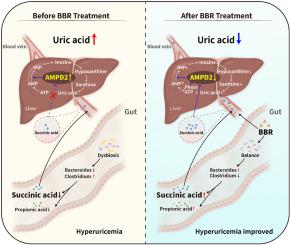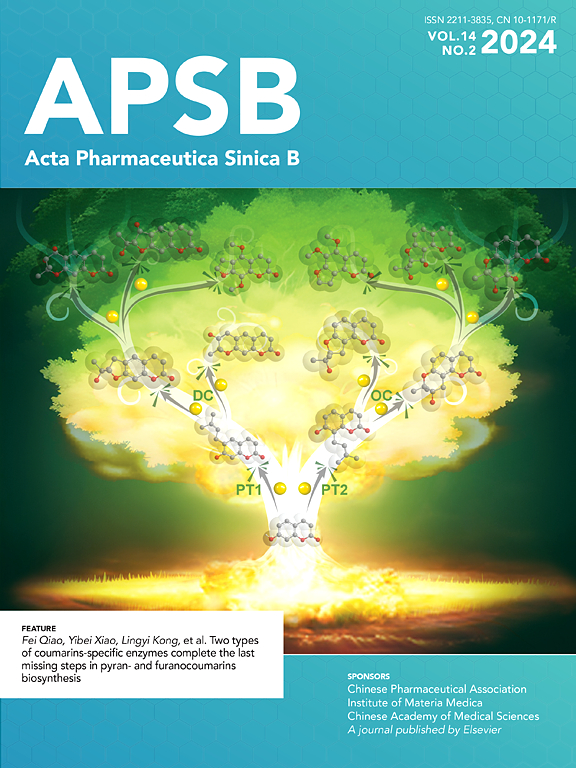脆弱拟杆菌衍生的琥珀酸通过抑制肝脏AMPD2促进尿酸的降解:了解植物小檗碱如何改善高尿酸血症
IF 14.6
1区 医学
Q1 PHARMACOLOGY & PHARMACY
引用次数: 0
摘要
近几十年来,由于生活方式的改变,高尿酸血症和痛风的患病率急剧增加。目前推荐用于高尿酸血症的药物存在不良反应,限制了其临床应用。在这项研究中,我们报道了小檗碱(BBR)是治疗高尿酸血症的有效候选药物,其机制可能涉及调节肠道微生物群及其代谢物琥珀酸。BBR在急性和慢性高尿酸血症动物模型中均显示出良好的治疗效果。在一项临床试验中,22名参与者口服BBR 6个月,通过调节肠道微生物群来降低血尿酸水平,从而导致拟杆菌的丰度增加和严格感梭菌的减少。此外,将脆弱拟杆菌移植到ICR小鼠体内,结果显示脆弱拟杆菌对尿酸的治疗作用与BBR相似。值得注意的是,拟杆菌的代谢物琥珀酸显著降低了尿酸水平。随后的细胞和动物实验表明,肠道代谢物琥珀酸通过抑制腺苷单磷酸脱氨酶2 (AMPD2)调节肝脏上游尿酸合成途径,AMPD2是一种负责将腺苷单磷酸(AMP)转化为肌苷单磷酸(IMP)的酶。这种抑制导致IMP水平下降和磷酸盐水平增加。IMP的减少导致下游次黄嘌呤、黄嘌呤和尿酸的产生减少。BBR也表现出良好的肾保护作用,改善高尿酸血症肾病。总之,BBR有潜力通过肠-肝轴有效治疗高尿酸血症。本文章由计算机程序翻译,如有差异,请以英文原文为准。

Bacteroides fragilis-derived succinic acid promotes the degradation of uric acid by inhibiting hepatic AMPD2: Insight into how plant-based berberine ameliorates hyperuricemia
In recent decades, the prevalence of hyperuricemia and gout has increased dramatically due to lifestyle changes. The drugs currently recommended for hyperuricemia are associated with adverse reactions that limit their clinical use. In this study, we report that berberine (BBR) is an effective drug candidate for the treatment of hyperuricemia, with its mechanism potentially involving the modulation of gut microbiota and its metabolite, succinic acid. BBR has demonstrated good therapeutic effects in both acute and chronic animal models of hyperuricemia. In a clinical trial, oral administration of BBR for 6 months reduced blood uric acid levels in 22 participants by modulating the gut microbiota, which led to an increase in the abundance of Bacteroides and a decrease in Clostridium sensu stricto_1. Furthermore, Bacteroides fragilis was transplanted into ICR mice, and the results showed that Bacteroides fragilis exerted a therapeutic effect on uric acid similar to that of BBR. Notably, succinic acid, a metabolite of Bacteroides, significantly reduced uric acid levels. Subsequent cell and animal experiments revealed that the intestinal metabolite, succinic acid, regulated the upstream uric acid synthesis pathway in the liver by inhibiting adenosine monophosphate deaminase 2 (AMPD2), an enzyme responsible for converting adenosine monophosphate (AMP) to inosine monophosphate (IMP). This inhibition resulted in a decrease in IMP levels and an increase in phosphate levels. The reduction in IMP led to a decreased downstream production of hypoxanthine, xanthine, and uric acid. BBR also demonstrated excellent renoprotective effects, improving nephropathy associated with hyperuricemia. In summary, BBR has the potential to be an effective treatment for hyperuricemia through the gut–liver axis.
求助全文
通过发布文献求助,成功后即可免费获取论文全文。
去求助
来源期刊

Acta Pharmaceutica Sinica. B
Pharmacology, Toxicology and Pharmaceutics-General Pharmacology, Toxicology and Pharmaceutics
CiteScore
22.40
自引率
5.50%
发文量
1051
审稿时长
19 weeks
期刊介绍:
The Journal of the Institute of Materia Medica, Chinese Academy of Medical Sciences, and the Chinese Pharmaceutical Association oversees the peer review process for Acta Pharmaceutica Sinica. B (APSB).
Published monthly in English, APSB is dedicated to disseminating significant original research articles, rapid communications, and high-quality reviews that highlight recent advances across various pharmaceutical sciences domains. These encompass pharmacology, pharmaceutics, medicinal chemistry, natural products, pharmacognosy, pharmaceutical analysis, and pharmacokinetics.
A part of the Acta Pharmaceutica Sinica series, established in 1953 and indexed in prominent databases like Chemical Abstracts, Index Medicus, SciFinder Scholar, Biological Abstracts, International Pharmaceutical Abstracts, Cambridge Scientific Abstracts, and Current Bibliography on Science and Technology, APSB is sponsored by the Institute of Materia Medica, Chinese Academy of Medical Sciences, and the Chinese Pharmaceutical Association. Its production and hosting are facilitated by Elsevier B.V. This collaborative effort ensures APSB's commitment to delivering valuable contributions to the pharmaceutical sciences community.
 求助内容:
求助内容: 应助结果提醒方式:
应助结果提醒方式:


